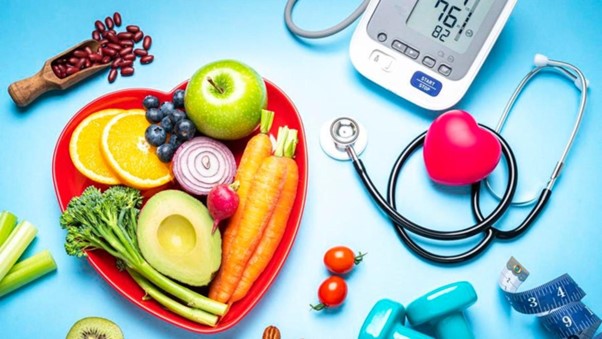Hypertension is another term for high blood pressure. It silently afflicts millions around the world. Often called the “silent killer” because its first stages are symptomless, it gives rise to a elevated risk to human life. Amongst all the aids that exist in the maintenance of hypertension, diet is considered to be one of the most effective.
There are foods that increase and exacerbate blood pressure, and there are others that decrease blood pressure levels. Therefore, it only makes common sense that awareness about which foods to indulge in and which to avoid may better the management of hypertension, thus leading to a healthier heart and circulatory system.
Nutrition and Blood Pressure
Diet is a crucial component of heart health and blood pressure control. The nutritional intake is directly responsible for the flexibility of blood vessels, sodium content, as well as balances in volumes of fluids that exist within your body-considerations all related to blood pressure. Some of the most important nutrients whose consumption above or below ideal levels could cause fluctuations in blood pressure include sodium, potassium, magnesium, and calcium. Second, processed foods, chock-full of unhealthy fats and hidden sugars, have become a significant contributor to increased blood pressure levels over time. Mindful choices in what we consume cannot prevent hypertension; however, diet can be a powerful ally in managing it.
Hypertensives combine dietary changes with medications like labetalol 100 for better management of their conditions. Labetalol 100, a medication used to treat high blood pressure, indeed works well with a diet plan for hypertension, thus giving the individual an all-encompassing control over his/her blood pressure.
Recommended Foods for Lower Blood Pressure
Though managing hypertension is challenging, a wide range of foods can help promote more favorable blood pressure levels. In most cases, such foods are not rich in sodium and contain valuable minerals that promote the well-being of the cardiovascular system.
1. Leafy Greens
Extra beneficial for hypertensive people are leafy green vegetables: spinach, kale, arugula, and collard greens; they contain potassium, which levels out sodium inside the body, therefore reducing its impact on the blood pressure. Berries can be added to salads, smoothies, or lightly sautéed as a side dish, adding flexibility and nutritional value to the meal.
2. Berries
Berries: A good source of natural antioxidants, flavonoids. Such compounds have been shown to modestly lower blood pressure. It is a great and healthy snack and great to add to oatmeal or yoghurt as it does not weigh too much with added sugars.
3. Bananas
Bananas are a handy and great source of potassium in managing blood pressure. This is one of the common fruits that are easy to take with one wherever they go, adding convenience to your meals. Bananas, as well as other sources of potassium, make for a better equilibrium of electrolytes in the body, which helps in blood pressure.
4. Fatty Fish Have Omega-3 Fatty Acids
Omega-3 fatty acids are a concentrated source of unsaturated fats found in fatty fish such as salmon, trout, and mackerel. They enhance many aspects regarding cardiovascular health, including inflammation, triglycerides, and the ability to enhance blood vessel function-all those factors that serve in the management of blood pressure. Bring these into your meals at least two times a week for maximum benefits.
5. Oats and Whole Grains
High in the fiber, whole grains, particularly oats, are known to keep blood pressures under check. Fiber flushes out extra cholesterol and helps a person control his weight; therefore, consuming whole grains lowers blood pressure. The fine line is switching refined grains to whole grains like brown rice and quinoa or whole wheat bread helps individuals with high blood pressure.
Foods to Avoid for Better Blood Pressure Control
Many foods help to promote healthy blood pressure, and many others increase the risk for developing hypertension. Main offenders who raise levels of blood pressure are typically processed foods, excessive amounts of salt, and trans fats. Being aware of what to limit or avoid can make the heart-healthy diet even more helpful.
1. Processed Foods High in Sodium
Sodium is also a major contributor because it promotes water retention within the body, thereby increasing blood volume and putting much pressure on the blood vessels. Canned soups, frozen dinners, and snacks are especially high in sodium and, therefore, most harmful to the hypertensive patient. Use low-sodium alternative when possible, or cook meals from fresh to have one more control over one’s sodium intake.
2. Sugar Drinks
Consumption of sugar drinks, such as soda and sweetened juice, leads to weight gain and insulin resistance. These last two contribute to lowering blood pressure, therefore should be avoided. Mostly, added sugars comprise sugars in sugar drinks, causing immediate spikes in blood sugar that contribute eventually to metabolic complications arising in the course of treatment for hypertension. One simply switches sugar drinks for water or any other variety of herbal teas and natural fruit-infused water.
3. Red Meat
Red meats, including beef, pork, and lamb, contain saturated fats that may lead to a rise in cholesterol, and this way, to increased blood pressure over a long time. Processed meat especially products like bacon, sausages, and cold cuts are particularly worse due to containing both saturated fats and high amounts of sodium. Reducing intakes of red and processed meat and substituting with poultry and legumes as protein sources will help reduce blood pressure.
4. Alcohol
Moderate levels of alcohol consumption have several cardiovascular benefits, but excessive use of alcohol is linked to hypertension. Some alterations in blood vessels and stimulation of the central nervous system may cause an elevation in blood pressure due to alcohol. Thus, limiting alcohol to sensible amounts may be the best management strategy for hypertension in people.
5. Trans Fats and Hydrogenated Oils
Highly hazardous to the cardiovascular system, trans fatty acids are most commonly found in fried foods, baked goods, and margarine. These fats increase the levels of bad cholesterol while simultaneously stimulating arterial inflammation, all factors contributing to high blood pressure. In general, it is prudent to avoid “partially hydrogenated oils” as the highest content of trans fats in processed foods.
Balanced Diet: Building a Hypertension-Friendly Diet
For patients with hypertension, a diet should be the starting point for a blood pressure-friendly diet, which adopts the general principles of a balanced diet using such whole foods as fiber, vitamins, and minerals. An adoption of the Dietary Approaches to Stop Hypertension (DASH) eating plan, which focuses on fruits, vegetables, lean proteins, and low-fat dairy products is often recommended to reduce blood pressure through the limitation of sodium and increasing potassium, magnesium, and calcium intake.
This diet also promotes heart health because it contains healthy fats from nuts, seeds, and olive oil. Minimizing intake of processed foods and high sugar-containing goods further promotes blood pressure stability.
Practical Choices for the Future
A diet for hypertension can be invaluable but also requires monitoring of progress and some readjustments. The interaction of dietary interventions with medication, such as labetalol 100, will question hypertension in all directions. Routine follow-up with the review of a diet and health care providers’ collaboration ensures that the diet becomes support for optimized blood pressure levels.
Wrapping Up
A diet heart friendly, well balanced, avoiding some food items but consuming others beneficent and detrimental towards hypertension management would be ideal. People having high blood pressure can take control of their cardiovascular wellness and most importantly self-initiate efforts to keep health risks at bay. By knowing such dietary habits and adapting to them by making changes in daily foods consumptions and intake, wellness could promote and avoid several risks of health issues.
What one should know about high blood pressure symptoms and better understand the high blood pressure and other symptoms of the condition, this can indeed prove important information as well on the widespread disorder and treatment of the same.
Also Read: India’s life expectancy rises; diabetes, hypertension rate high: Report







